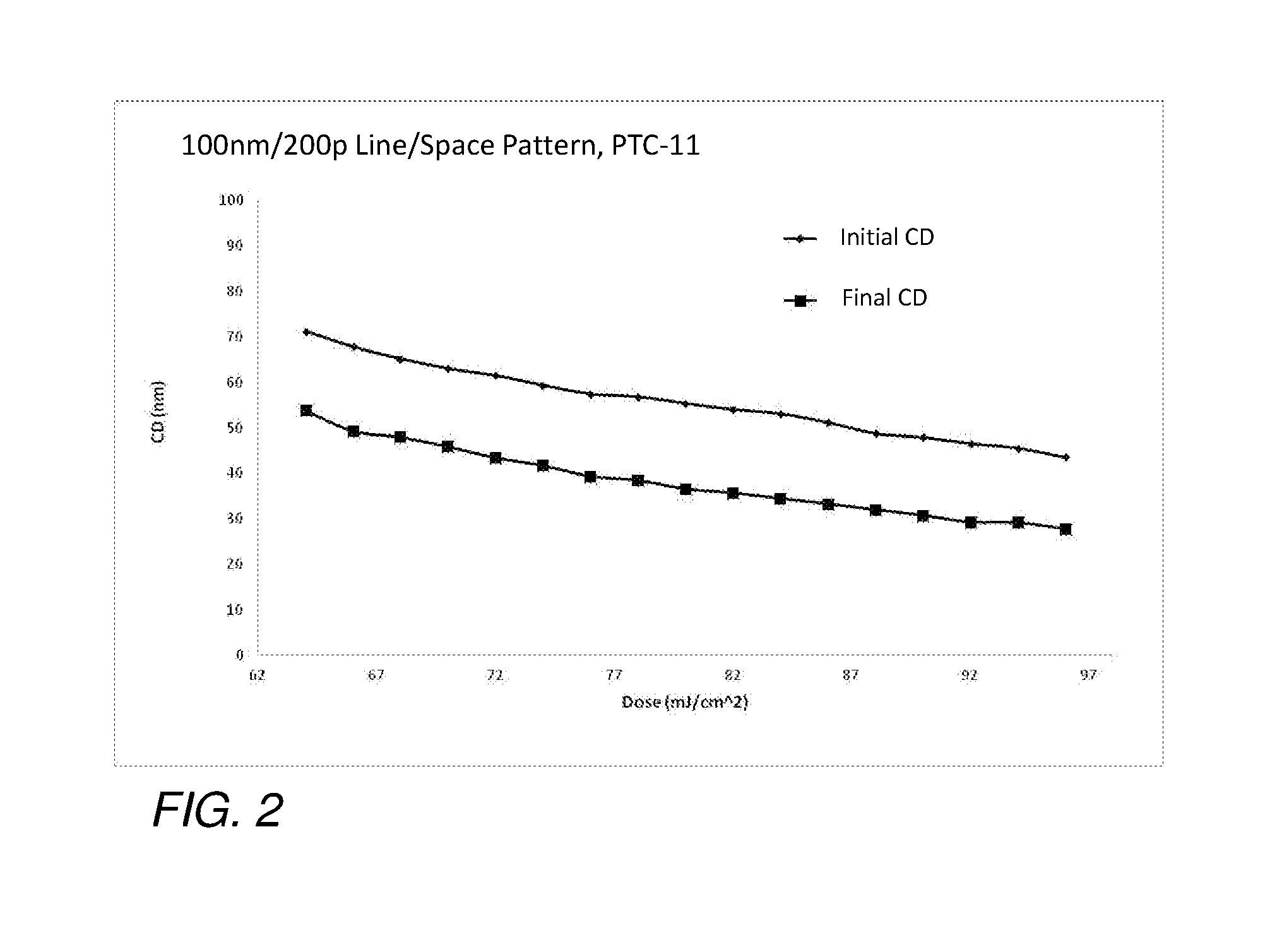Compositions and methods for pattern treatment
a pattern and composition technology, applied in the field of compositions for treating patterns and pattern treatment methods, can solve the problems of inability to achieve high-resolution patterns, add to the complexity of the process, and disadvantage in the process throughput, etc., and achieve the effect of high-resolution patterns
- Summary
- Abstract
- Description
- Claims
- Application Information
AI Technical Summary
Benefits of technology
Problems solved by technology
Method used
Image
Examples
example 1
[0075]0.019 g dimethyl 2,2′-azobis(2-methylpropionate) (DMAMP), 10 g monomer M4, 15 g monomer M10, 0.114 g 2-cyanopropan-2-yl benzodithioate (CPBD), 32 mL PGMEA and a magnetic stir bar were loaded into a 200 mL air-free flask. The mixture was freeze-pump-thawed three times with liquid nitrogen and the flask was then placed in a heat block at 70° C. for 16 hours. After the reaction, the flask was cooled. The reaction mixture was then precipitated into 500 mL of methanol. The precipitate was collected and re-precipitated. The polymer was collected and dried in a vacuum oven at 50° C. overnight. The resulting Polymer PP-1 had an Mn of 36 k (kg / mol) and a PDI of 1.15.
examples 2-6
[0076]Polymers PP-2 to PP-6 were synthesized using a similar procedure as described above for Polymer PP-1, with the materials and amounts shown in Table 1. “Monomer A” and “Monomer B” were fed to the reactor at the same time.
TABLE 1ExamplePolymerMnPDICPBDDMAMPSolventMonomer AMonomer B1PP-136k1.150.114 g0.019 gPGMEAM4M10 (32 mL)(10 g) (15 g)2PP-267k1.330.097 g0.016 gPGMEAM3M4 (23 mL)(6.4 g) (15 g)3PP-335k1.240.068 g0.012 gPGMEAM4M6 (13 mL)(10 g)(2.5 g)4PP-415.6k 1.230.74 0.023PGMEAM1M7(17.4 mL) (5 g)(9.7 g)5PP-515.6k 1.220.0670.019PGMEAM1M8(22.7 mL)(10 g)(3.5 g)6PP-618k1.23 0.81 g0.023 gPGMEAM1M9(18.5 mL)(10 g)(6.25 g) CPBD = 2-cyanopropan-2-yl benzodithioate; DMAMP = Dimethyl 2,2′-azobis(2-methylpropionate).
Block Copolymer Synthesis
example 7
[0077]10 g Polymer PP-1, 2 g Monomer M13, 0.007 g dimethyl 2,2′-azobis(2-methylpropionate) (DMAMP), 25.44 mL dioxane and a magnetic stir bar were loaded into a 200 mL air-free reactor. The mixture was freeze-pump-thawed three times with liquid nitrogen. The reactor was then sealed with a septum and placed in a heat block at 70° C. for 16 hours. After the reaction, the flask was cooled. The reaction mixture was then precipitated into 500 mL methanol. The precipitate was collected and re-precipitated. The resulting Polymer P-1 was collected and dried in a vacuum oven at room temperature overnight.
PUM
| Property | Measurement | Unit |
|---|---|---|
| compositions | aaaaa | aaaaa |
| density | aaaaa | aaaaa |
| refractive index | aaaaa | aaaaa |
Abstract
Description
Claims
Application Information
 Login to View More
Login to View More - R&D
- Intellectual Property
- Life Sciences
- Materials
- Tech Scout
- Unparalleled Data Quality
- Higher Quality Content
- 60% Fewer Hallucinations
Browse by: Latest US Patents, China's latest patents, Technical Efficacy Thesaurus, Application Domain, Technology Topic, Popular Technical Reports.
© 2025 PatSnap. All rights reserved.Legal|Privacy policy|Modern Slavery Act Transparency Statement|Sitemap|About US| Contact US: help@patsnap.com



